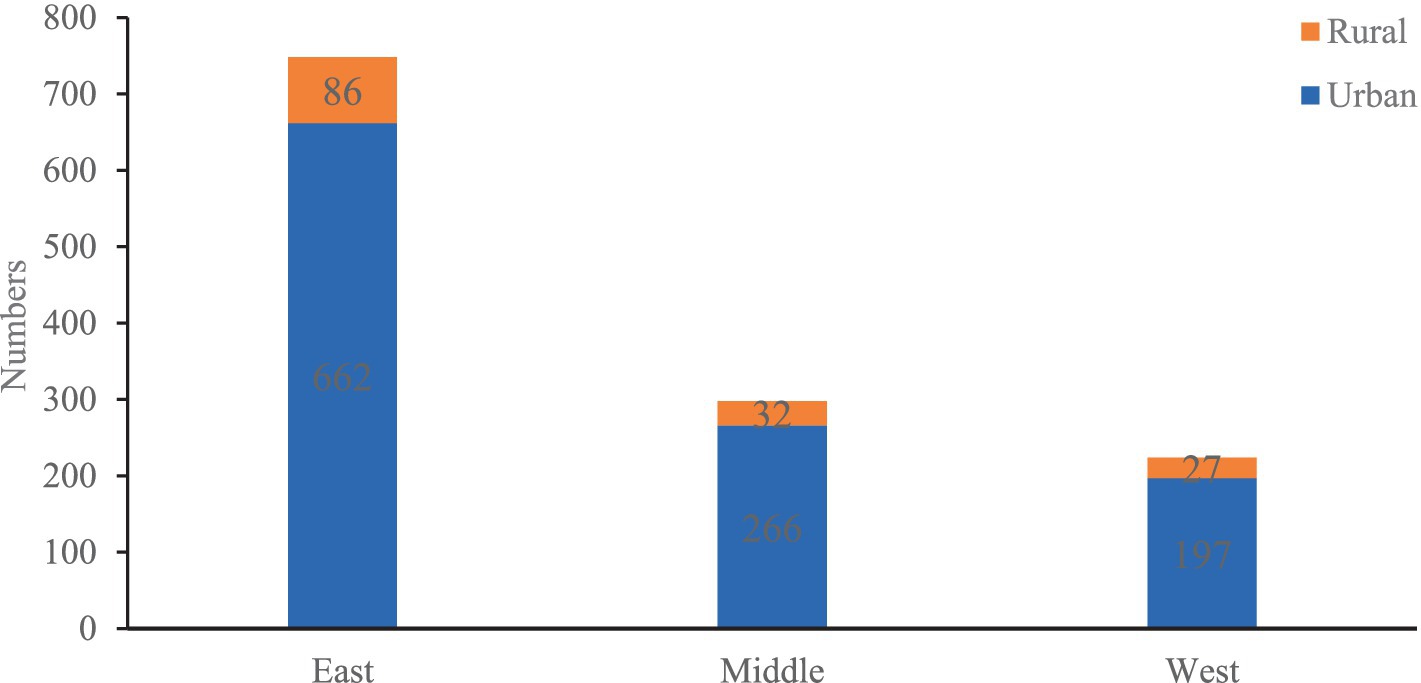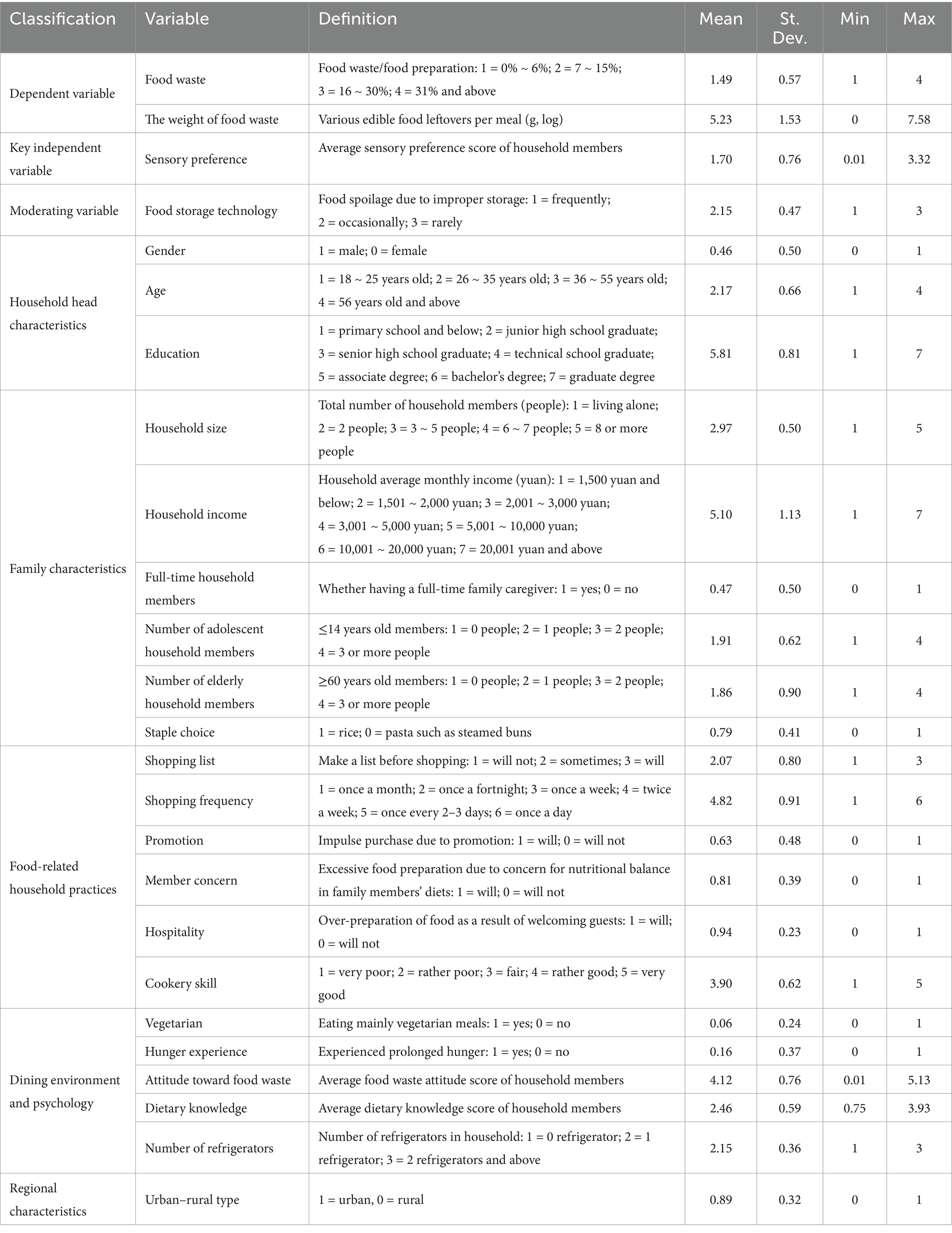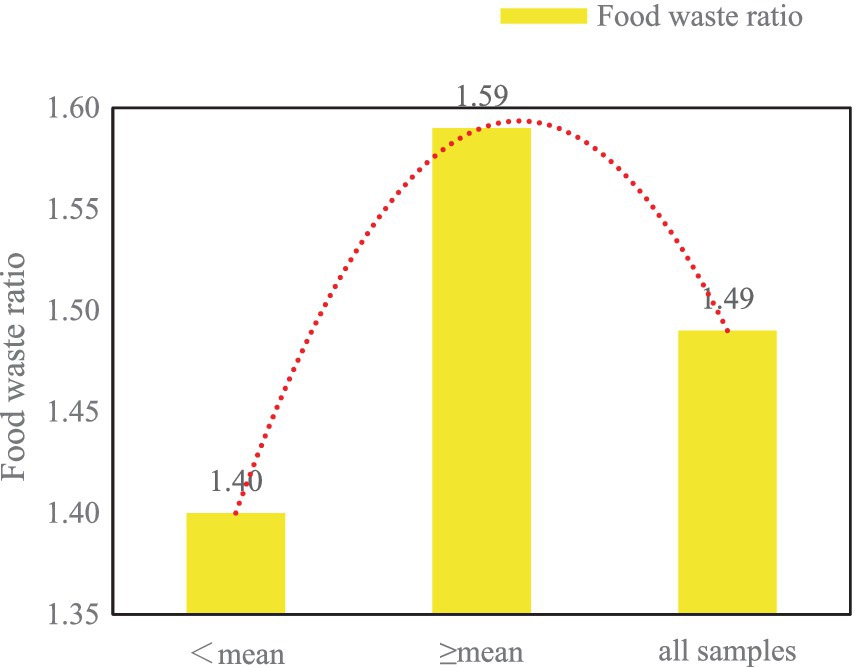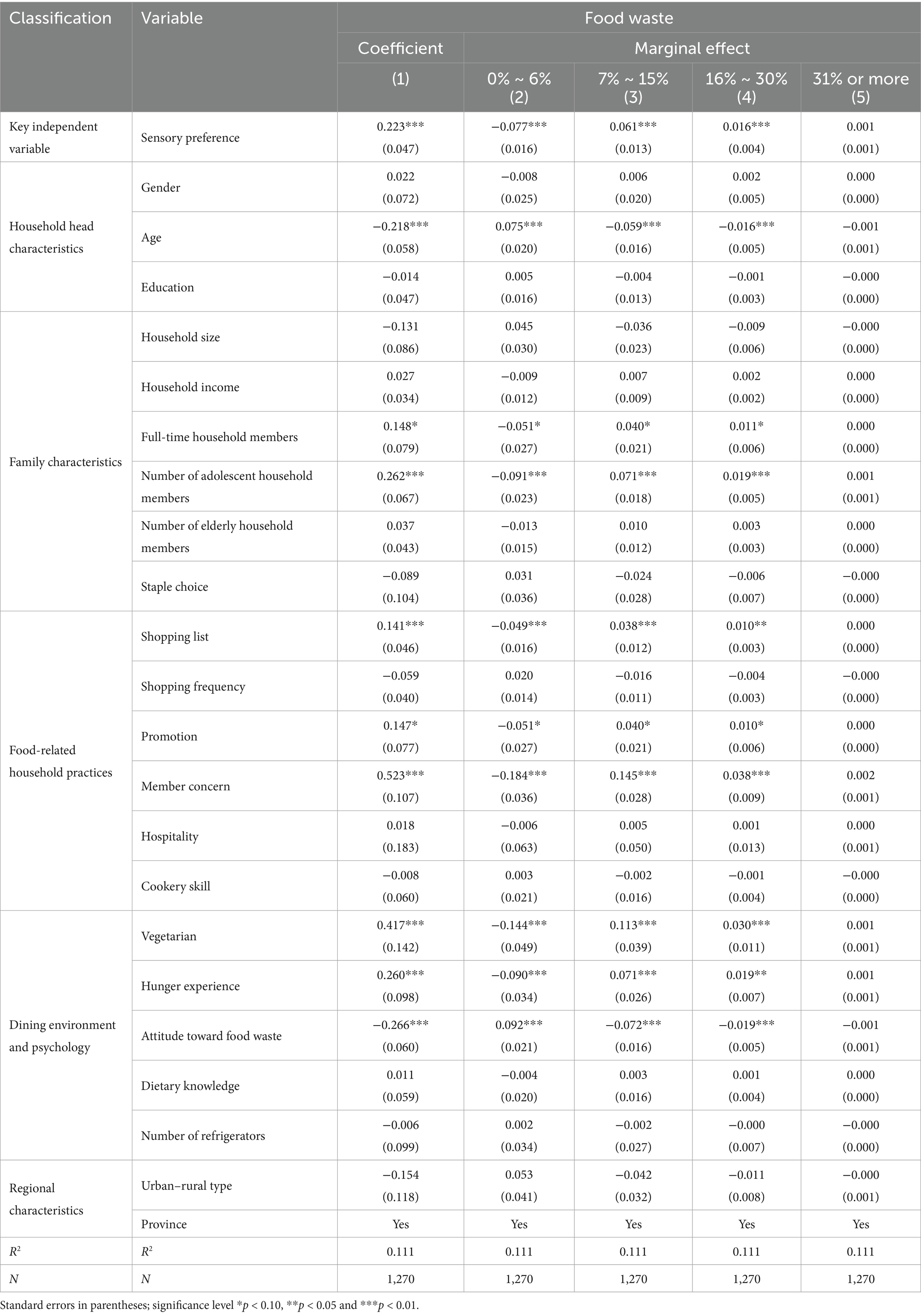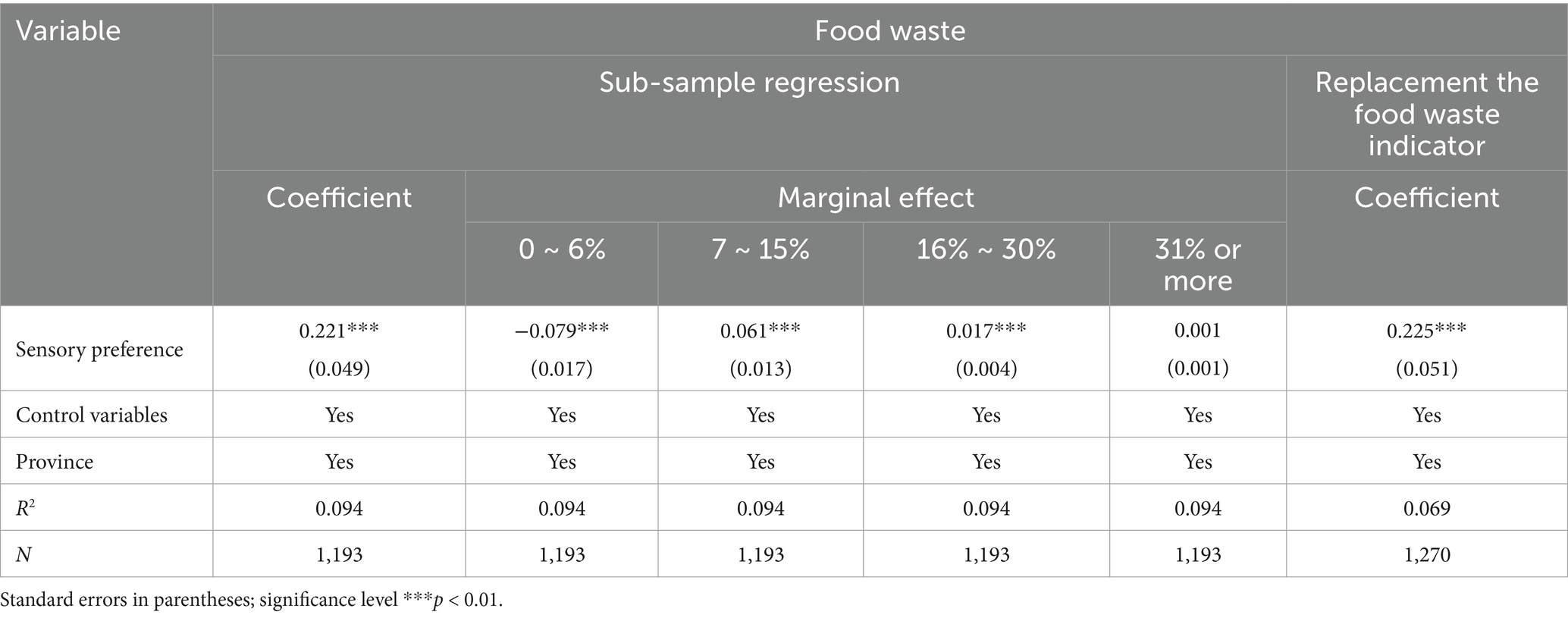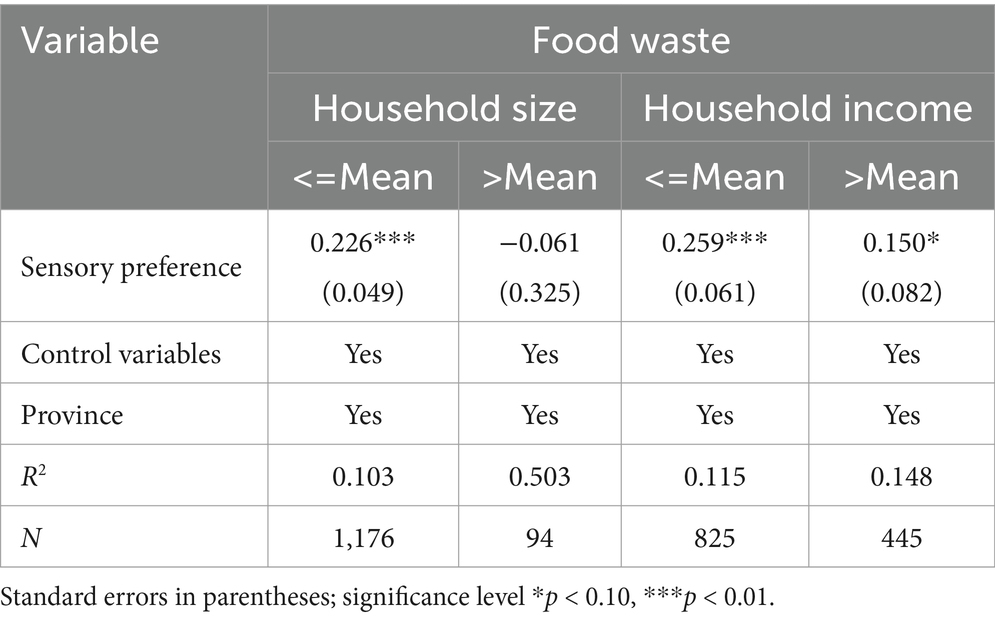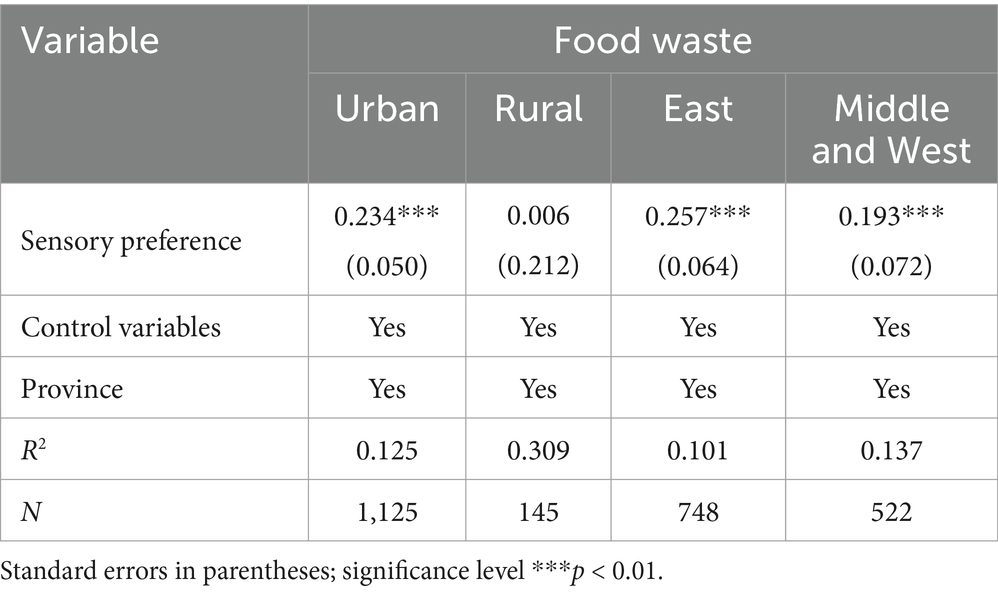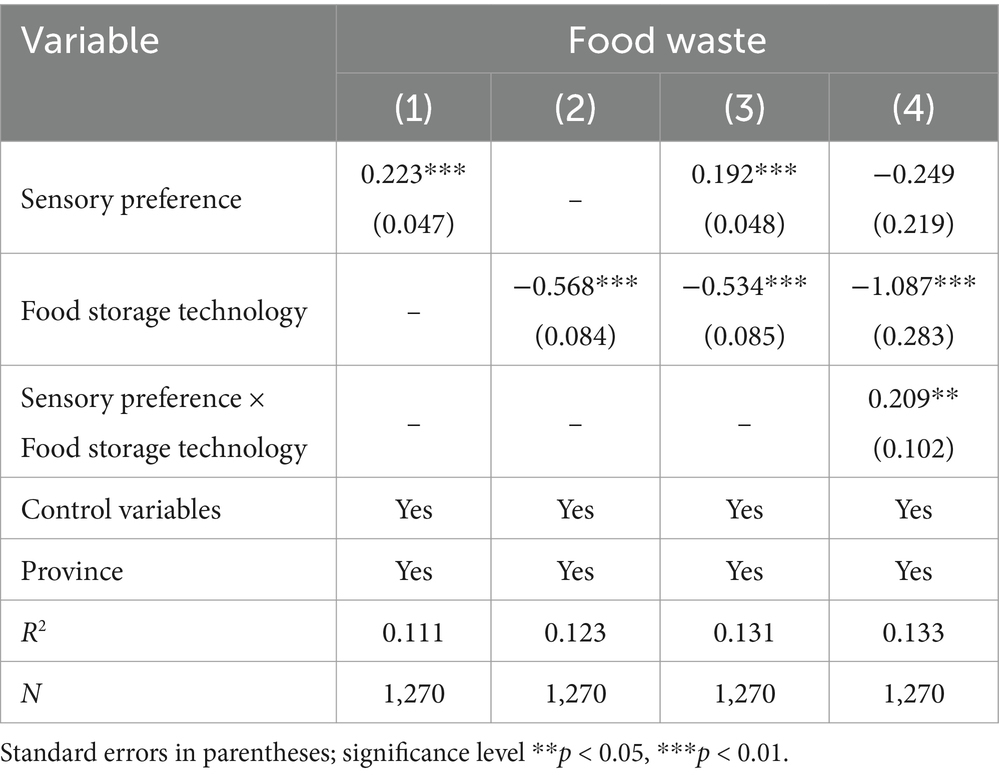- 1Institute of Food and Strategic Reserves, Nanjing University of Finance and Economics, Nanjing, China
- 2School of Economics, Nanjing University of Finance and Economics, Nanjing, China
- 3School of Business, Jiangsu Open University, Nanjing, China
Household food waste contributes to 60% of total global food waste. Based on an online questionnaire survey on household food waste in China, this paper explores the association between sensory preference and household food waste using an Oprobit model. The results show that (1) higher sensory preference scores were associated with higher levels of household food waste. The robustness tests supported this finding. (2) heterogeneity analysis showed that the impact of sensory preference on household food waste varied by the gender, age and education level of respondents, household size, per capita income level, urban–rural type and regional distribution. (3) mechanistic analyses found a moderating effect of food storage technology on the increased food waste effect of sensory preference. Increased food storage technology weakened the effect of sensory preference on household food waste. Therefore, it is necessary to popularize the knowledge of food nutrition and raise the awareness of ‘Love Food, Save Food’ and storage technology to reduce household food waste.
1 Introduction
Food loss and waste is an international issue that has garnered significant attention from the academic community in recent years. Food loss and waste is often used as one category, encompassing all stages of the food supply chain (Amicarelli et al., 2021). However, there is a difference between the two. According to the Food and Agriculture Organization of the United Nations (Gustavsson et al., 2011), food loss refers to any phenomenon that changes the availability, edibility, healthy properties, or quality of food, thereby reducing its value. Food loss that occurs at the consumption stage is considered as food waste. According to a United Nations Environment Programme report, the global total of food waste reached 1.05 billion tons in 2022, with an average of 132 kilograms of food wasted per person, accounting for one-fifth of the total food available to consumers (United Nations Environment Programme, 2024). At the same time, approximately 733 million people worldwide faced hunger in 2023, equivalent to 9.1% of the global population. Regarding food waste in specific countries, Keegan and Breadsell (2021) stated that Australian households wasted 7.3 million tons of food per year. Amicarelli et al. (2021), based on Italy’s agri-food system, stated that Italian food waste exceeded 8.5 million tons per year. China, as a developing country with a population of over 1.4 billion, has seen increasingly prevalent food waste among its citizens as living standards improve and consumption patterns upgrade. According to statistics, the total amount of food waste in China each year was about 120 million tons (Zhang et al., 2024), with household food waste alone reaching 14.36 million tons annually (Jiang et al., 2018).
Food waste not only threatens food security, but also causes a huge waste of resources, which brings a series of negative environmental effects that cannot be ignored (Tonini et al., 2018; FAO, 2019; Pitoska and Damianos, 2023). On the one hand, food waste implies the ineffective depletion of elemental resources such as water, soil, and fertilizers invested in the production stage (Thyberg and Tonjes, 2016; Song et al., 2018). On the other hand, wasted food generates environmental burdens such as heavy metal pollution and carbon dioxide emissions (Song et al., 2015; Skaf et al., 2021). It has been shown that the global food system emitted the equivalent of 18 Gt CO2eq per year, which was 34% of the total greenhouse gas(GHG) emissions (Crippa et al., 2021). Food waste generated 3.3 Gt CO2eq, which was about 7% of the total greenhouse gas (GHG) emissions (Qian et al., 2022; FAO, 2019). Therefore, in the context of food security and sustainable development strategies, it is of great theoretical and practical significance to study the causes of household food waste and give specific suggestions for ‘food saving and loss reduction’.
2 Literature review
In studies on household food waste, scholars have paid more attention to its influencing factors and driving mechanisms. Firstly, the impact of sociodemographic characteristics on food waste has been widely studied. This includes individual-level factors such as gender (Li Y. et al., 2021; Annunziata et al., 2021), age (Chia et al., 2024), and education level (Scalvedi and Rossi, 2021), as well as household-level factors like household size (Scalvedi and Rossi, 2021) and structure (Scalvedi and Rossi, 2021; Pappalardo et al., 2020; Setti et al., 2018), household income and food expenditure (Li Y. et al., 2021; Zhang et al., 2018), and the geographical and cultural characteristics of the household (Ananda et al., 2021). Secondly, scholars have focused on the impact of individuals’ awareness of food waste issues. A lack of awareness regarding the environmental consequences of food waste has hindered efforts to prevent food waste in Australia (Hoek et al., 2017). Additionally, a study on American households indicated that parents’ intentions to educate their children about not wasting food and to set a good example can help reduce household food waste (Ahmed et al., 2021; Neff, 2015). Furthermore, Polish respondents noted that a culture that reinforces consumerist values promoted their efforts to reduce food waste (Misiak et al., 2020). Thirdly, food-related household practices can objectively lead to food waste. Unplanned shopping is a common barrier to reducing and preventing food waste, as it often results in excessive or impulsive purchases (Chia et al., 2024). Conversely, learning to home-cooked recipes and reusing leftovers can help reduce food waste (Ahmed et al., 2021; Babbitt et al., 2021). Finally, external information interventions (Pinto et al., 2018) and policy regulations (Halloran et al., 2014) may impact household food waste. Clear food waste legislation and campaigns promoting the ‘Clean Plate’ initiative, for example, aim to reduce household food waste by integrating green and environmentally friendly concepts into daily life. The ‘Clean Plate Campaign’ was initiated on Sina Weibo in early 2013 by a non-profit organization in Beijing (Mirosa et al., 2018). It aims to reduce food waste. As the campaign expanded from Beijing to other cities, more and more citizens, schools, restaurants, and organizations became involved. Consequently, more people became aware of the food waste problem and expressed their willingness to work toward reducing it.
As residents’ per capita income levels rise, food consumption has greater autonomy in choice. Sensory preference may be an important factor influencing food waste. On one hand, the demand for fresh food is one of the factors contributing to food waste (Neff, 2015). Compared to leftover food that looks unappealing, family members prefer fresh food that is perfect in taste, texture, and aroma (Aleshaiwi and Harries, 2021). On the other hand, food packaging also hinders the reduction of food waste (Chia et al., 2024). A box of dented juice may decrease consumers’ desire to purchase due to its lack of aesthetic appeal (De Hooge et al., 2017), leading to food waste. In Italy and Germany, Jörissen et al. (2015) found that large and non-resealable food packaging increased food waste. Additionally, subjective perceptions of taste are one of the reasons for discarding food (Heikkilä et al., 2016). Selective eating behavior and preference of children in particular can lead to over-preparation and supply of food by parents, which results in waste (Kansal et al., 2022). Therefore, it is reasonable to assume that consumers’ sensory preference is related to what and how much food is wasted. However, there are few studies on the relationship between sensory preference and food waste in residential households.
Given this, this paper focuses on the impact of consumer sensory preference on household food waste. It delves into the underlying mechanisms at play, which helps to deepen the understanding of the complex relationship between consumer sensory preference and household food waste. Meanwhile, the suggestions mentioned in this paper, such as popularizing food safety knowledge, guiding rational consumption (especially among low-income families), promoting refrigerator technology upgrades to strengthen food storage skills, also provide a scientific basis and practical experience for developing effective strategies to reduce food loss and waste.
3 Research design
3.1 Data collection
To obtain firsthand data on household food waste, a nationwide online survey was conducted between 21 January to 30 July 2024 through the Questionnaire Star platform. Initially, Anhui and Jiangsu provinces were selected for a preliminary investigation, and the survey questionnaire was continuously revised, ultimately resulting in a formal questionnaire by June 2024. This questionnaire was primarily distributed through Questionnaire Star Sample Service and WeChat promotion. The survey covered all 31 provinces (municipalities and autonomous regions) in mainland China, corresponding to 11 eastern provinces (Beijing, Tianjin, Hebei, Liaoning, Shanghai, Jiangsu, Zhejiang, Fujian, Shandong, Guangdong, Hainan), 8 central provinces (Shanxi, Jilin, Heilongjiang, Anhui, Jiangxi, Henan, Hubei, Hunan), and 12 western provinces (Sichuan, Chongqing, Guizhou, Yunan, Tibet, Shaanxi, Gansu, Qinghai, Ningxia, Xinjiang, Guangxi, Inner Mongolia). The samples were randomly drawn according to the population proportions of each province as per the 7th Population Census. After more than a month of formal investigation, data on food waste from 1,270 households across 31 provinces were collected (Figure 1).
The questionnaire consists of four parts. Part I mainly contained socio-demographic information of the respondents, such as gender, age, education level at the individual level and household size, structure and average income at the household level. Part II reported on household food waste. It mainly recorded the weight and proportion of household food wastage per meal. Part III tallied information related to the households’ food preparation stage. Specifically, it included shopping lists, shopping frequency, and cooking techniques. Part IV addressed the dining environment and psychology. It focused on the diners’ psychological preferences regarding food and the external environment provided for food.
3.2 Variable settings
3.2.1 Food waste
Food waste, as referred to in this questionnaire, refers to food that is originally edible but is not consumed for some reason. This includes, but is not limited to, leftover food that is no longer eaten (feeding pets and composting are both considered no longer eating), and food discarded due to expiration, spoilage, or being stored for too long. However, it does not include vegetable stalks, leaves, fruit and vegetable peels and cores, bone scraps, etc., that are discarded during food washing, processing, cooking, or consumption.
Referring to existing studies (Qian et al., 2024; Boschini et al., 2018), the level of household food waste was measured using interval data, which was categorized into four grades, with higher grades having greater levels of waste. Specifically, 1st represented waste of 0 to 6%; 2st represented waste of 7 to 15%; 3st represented waste of 16 to 30%; 4st represented waste of 31% and above.
3.2.2 Sensory preference
Drawing on relevant literature (Szymkowiak et al., 2022; De Hooge et al., 2017), a composite score was calculated using the entropy method, based on the respondents’ handling of foods that were not fresh in color, not packaged well enough, presenting overly strong odors, and having a taste that was too oily or sweet. It was used to measure the degree of sensory preference.
3.2.3 Control variables
Referring to the existing literature (Qian et al., 2024; Berjan, 2022), this paper introduced multiple variables across dimensions such as respondents’ sociodemographic characteristics, food-related family practices, dining environments and psychological factors to mitigate the issue of omitted variable bias as much as possible. Specifically, respondents’ gender, age and education level were controlled for as respondents were the primary makers of household dietary decisions. Because household size, structure, and economic level directly affected the amount of household food waste, household-level variables including household average monthly income, household size, the number of household members under 14 years old, the number of household members over 60 years old, and the household staple food category were selected. Existing research indicated that the shopping list and shopping frequency of household purchasers, as well as supermarket discount promotion strategies, influenced the amount of food purchased at one time, and thus household food waste (Berjan, 2022). Simultaneously, a culture of hospitality and food cooking skills determined the amount of ingredients and table food prepared (Quested et al., 2013). Considering that the food intake of household members and guests was limited, this presented a risk of food waste. Therefore, food-related household practices included variables such as shopping lists, shopping frequency, promotion, hospitality, and cooking skills. Finally, past experiences, dietary knowledge, and ethics could influence household members’ food consumption choices, and the number of household refrigerators affected the possibility of secondary food utilization (Zhang et al., 2024). Dining environment and psychology included variables such as vegetarianism, experience of hunger, attitudes toward food waste, dietary knowledge and the number of household refrigerators. Additionally, urban–rural type and regional differences were introduced to control for potential regional-level influences. The definitions and descriptive statistics of the variables were shown in Table 1.
3.2.4 Moderating variable
The moderating variable discussed in this paper was food storage technology. Referring to the existing studies (Davenport et al., 2019), the household food storage technique score was examined in terms of the frequency of food spoilage due to improper storage. Improper storage was categorized into situations such as not putting food in the refrigerator in time or forgetting to use it after storage. The food storage technology score ranged from 1 to 3, with higher values indicating better household food storage practices.
3.3 Model settings
Referring to Qian et al. (2022), the following model was established to verify the effect of sensory preference on household food waste:
Where Food-waste is the explanatory variable household food waste level. Sensory-preference is consumer sensory preference. X is the control variable. is the coefficient of the variable, and ε is the random error term, with i indicating the i-th respondent. This paper verifies the impact of sensory preference on household food waste through Equation 1.
For specific model selection, the dependent variable in the paper is the level of household food waste (taking the values of 1, 2, 3, and 4), which has a natural ordering, so the Oprobit model was used to analyse it empirically.
4 Empirical results and analysis
4.1 Descriptive analysis
To intuitively describe the relationship between consumer sensory preference and household food waste, this paper first conducted a simple descriptive analysis, as shown in Figure 1. Overall, the average level of food waste in households was 1.49. For households with sensory preference scores equal to or greater than the mean, the level of food waste was 1.59. For households with sensory preference scores below the mean, the level of food waste was 1.40. The difference in waste levels between the two groups passed the t-test at the 1% significance level. Figure 2 provides preliminary evidence that households overly focused on sensory preference tend to increase food waste.
4.2 Benchmark regression
In accordance with Equation 1, a fitted regression was conducted to analyze the impact of sensory preference on household food waste, with the regression coefficients presented in Table 2, Column (1). To investigate the economic significance of sensory preference on household food waste, a marginal transformation of the regression coefficients was performed, with results shown in Table 3, Columns (2) to (5). It was found that after controlling for other factors influencing household food waste as much as possible, sensory preference significantly and positively affected household food waste. As consumers’ sensory preference scores increased, the level of household food waste also risen. In terms of marginal effects, the probability of household food waste levels being between 0 and 6% decreased by 7.7%, while the probabilities for household food waste levels in the ranges of 7 to 15% and 16 to 30% increased by 6.1 and 1.6%, respectively.
In terms of control variables, age and adolescent members of the household reflecting individual and household characteristics of the respondents, shopping lists and members’ concerns reflecting food-related household practices, and vegetarianism, experience of hunger and attitudes toward food waste reflecting the dining environment and psychology had a significant effect on the level of household food waste. Specifically, self-reported levels of household food waste were lower among older adults compared to younger adults. On one hand, older adults have higher cooking skills, and on the other hand, the notion of valuing food helps to reduce and prevent food waste (Chia et al., 2024; Li Y. et al., 2021). Families with infants and adolescents experienced a higher frequency of food waste (Tonini et al., 2023). This may be due to the fact that parents are overly concerned about the food safety relying solely on food date labels to assess food quality, leading to the waste of expired but still acceptable food (Li et al., 2020). Families that tended to use shopping lists also experienced more food waste. Strict adherence to a pre-planned shopping list may result in purchasing excess food, affecting consumers’ flexibility during actual purchases (Chia et al., 2024). Concern for family members can lead to increase food waste. Children’s selective eating behaviors and parents’ cautious food safety preference may cause parents to overprepare and supply food, resulting in waste (Kansal et al., 2022). Motivations for vegetarianism could significantly increase household food waste levels. Beliefs based on vegetarianism may reduce consumption of other food categories, thus contributing to household food waste (Li et al., 2023). Experiences of hunger could significantly increase household food waste levels. It has been shown that experiences of hunger in childhood leaded new affluent classes to develop compensatory consumption psychology, resulting in greater food waste (Hao et al., 2024). Attitudes toward food waste negatively influenced household food waste behavior. Households with negative attitudes toward food waste tended to reduce food waste in their daily lives. The Theory of Planned Behavior (TPB) posited that a person’s attitude could predict their intention to engage in a certain behavior, which in turn predicted the actual execution of that behavior. Individuals who believed that food waste is harmful to the environment and felt regret or guilt about wasting food tended to have lower household food waste, consistent with previous research findings (Stancu et al., 2016; Poonia et al., 2021).
4.3 Robust test
To further ensure the reliability of the research conclusions, two methods would be used for robustness testing: sample adjustment and variable substitution. The estimation results were shown in Table 3.
4.3.1 Sub-sample regression
To further investigate the impact of sensory preference on household food waste, this paper excluded data from households without food waste and conducted a subsample fitted regression (Table 3) to verify the robustness of the benchmark regression results. The results confirmed that sensory preference consistently had a significant positive effect on food waste in residents’ households.
4.3.2 Replacement the food waste indicator
To verify the robustness of the benchmark regression results, this section drew on Ding et al. (2022) and selected the weight of food waste (in logarithmic form) as the dependent variable to examine the effect of sensory preference on the absolute value of household food waste. The results showed (Table 3) that consumers’ sensory preference consistently had a positive impact on the amount of food waste in households, reaffirming the conclusion that higher sensory preference scores were associated with higher levels of household food waste.
4.4 Heterogeneity analysis
To clarify whether there was a heterogeneous relationship between sensory preference and household food waste with different characteristics, this paper drew on existing study (Min et al., 2021; Qian et al., 2022; Berjan, 2022) and conducted a comparative analysis based on factors such as the gender, age, and education level of household food decision-makers, differences in household size and economic status, as well as urban–rural type and regional disparities.
4.4.1 Gender, age, and education level
It has been shown that females exhibited completely different characteristics from males in food purchasing and discarding decisions due to nutritional balance considerations in household meals (Annunziata et al., 2021). Table 4 indicated that, compared to men, the sensory preference of female decision-makers had a smaller impact on household food waste. A possible explanation is that women are more sensitive to food prices than men, which partially offsets the influence of sensory preference on household food waste level (Annunziata et al., 2020).
Middle-aged and older age groups had higher competence in food literacy compared to younger age groups (Chia et al., 2024). A comparative analysis based on whether individuals were over 35 years old (Table 4) revealed that sensory preference among middle-aged and older adults had a greater impact on household food waste. This may be related to the fact that this demographic tends to have more accumulated wealth and places greater emphasis on food freshness and safety.
Differences in education levels could affect household food waste decisions, leading to varying levels of food waste (Scalvedi and Rossi, 2021; Annunziata et al., 2020). This paper, referencing Min et al. (2021) and Xu et al. (2020), conducted a comparative analysis based on whether education levels were above or below the mean (Table 4) and found that households with higher education levels had a smaller impact of sensory preference on food waste. Consumers with higher education levels exhibited greater concern and guilt about wasting food, which in turn reduced the influence of sensory stimuli on their disposal decisions (Annunziata et al., 2020).
4.4.2 Household size and household income
Household size could influence food purchasing and disposal decisions, leading to varying degrees of food waste (Pappalardo et al., 2020; Li et al., 2020). In this paper, the overall sample was divided into small-scale and large-scale households for comparative analyses according to whether the household size was larger than the mean (Table 5). The results indicated that the effect of sensory preference on household food waste was more pronounced in small households, where sensory preference significantly increased the level of food waste. In contrast, the effect of sensory preference on food waste in large households was not significant, which may be related to the smaller sample size of large households, making it difficult to reflect the impact of sensory preference on food waste patterns.
Given the differing impacts of income level on household food waste (Liu et al., 2023; Min et al., 2021; Ding et al., 2022; Qian et al., 2022), this paper grouped households based on whether their income was above or equal the mean. The analysis of the effect of sensory preference on household food waste (Table 5) revealed that, compared to households with higher income levels, those with average income below the mean exhibited a greater impact of sensory preference on food waste. A possible explanation is that low-income households tend to over-purchase discounted food, and due to limited consumption capacity, they end up discarding more items that are not fresh enough or have slightly inferior taste.
4.4.3 Urban–rural type and regional difference
There were significant differences in the dietary structure of urban and rural residents (Liu et al., 2023). According to the grouping by urban and rural household registration (Table 6), the analysis of the food waste effect of sensory preference revealed that, compared to rural areas, urban households’ sensory preference had a more pronounced impact on food waste. A possible explanation is that decision-makers in rural households, constrained by their level of knowledge and living pressures, pay less attention to sensory preference for food than urban residents. It results in fewer instances of food waste caused by an excessive focus on the appearance and taste of food.
Due to significant differences in economic development and human environment among the eastern, central, and western regions, these disparities may lead to regional variations in how sensory preference affect household food waste. In this paper, the research sample was divided into East, Middle and West regions for group estimation with the results shown in Table 6. The empirical findings indicated that sensory preference had a significant positive impact on the food waste in households across the eastern, central, and western regions. Compared to the central and western regions, the effect of sensory preference on food waste was greater in eastern households. A possible explanation is that the eastern region has a higher level of economic development, and a lower household food expenditure cost, making the influence of sensory preference on food waste more pronounced.
4.5 The regulatory role of food storage technology
To verify whether food storage technology had a moderating effect on the relationship between sensory preference and household food waste, this section introduced the interaction term between sensory preference and food storage technology for regression fitting. Table 7 listed the estimated results of household food waste step by step, including variables for sensory preference, food storage technology, and their interaction terms. The estimates for household food waste revealed that the interaction term between sensory preference and food storage technology significantly affected the household food waste. It indicated that food storage technology did play a moderating role in how sensory preference influence household food waste behavior.
Specifically, the last column (4) showed that the effect of sensory preference (−0.249 + 0.209 food storage technology) varied with changes in food storage technology (Equation 2).
It was calculated that food storage technology significantly weakened the effect of consumer sensory preference on household food waste. The sensory preference still positively affected the household food waste as food storage technology continued to improve, but this effect diminished.
5 Discussion
Reducing food waste at the household level is crucial for ensuring food security and sustainable development in China. The researches on consumer food preference, both domestically and internationally, provide new insights for minimizing household food waste. Therefore, it is of great practical significance to explore the impact of consumer preference differences on the level of food waste.
1. The study found that higher consumer sensory preference scores were associated with higher household food waste. This was consistent with the findings of previous studies (Neff, 2015; Aleshaiwi and Harries, 2021; Chia et al., 2024; De Hooge et al., 2017), confirming the significant impact of consumer sensory preference on household food waste. Therefore, it is important to promote food safety knowledge and strengthen consumers’ feelings of guilt about wasting food, encouraging them to actively reduce their subjective preference demands. Notably, unlike existing qualitative studies, this paper quantifies the impact of sensory preference on household food waste based on consumers’ scoring of their preference for food appearance, taste, smell and packaging.
2. Consider three dimensions of heterogeneity. (a) The differential impact of consumers’ sensory preference based on individual characteristics on household food waste. Heterogeneity analysis revealed that gender, age, and education level influenced the level of food waste associated with consumers’ sensory preference. Due to personality traits, wealth accumulation, and knowledge reserves, males, middle-aged and older individuals, and those with lower education levels exhibited a greater effect of sensory preference on food waste. (b) Consumers’ sensory preference had varying impacts on food waste levels in households with different characteristics. Objective factors such as household size and income level directly affected consumers’ subjective preferences, thereby leading to differentiated impacts on their food waste decisions. (c) The differential impact of consumers’ sensory preference on household food waste was reflected in urban–rural type and regional differences. The objective differences in urban and rural living leaded consumers to focus differently on personal preferences, resulting in varying effects of sensory preference on food waste. Differences in transportation conditions and economic development between the eastern and central-western regions created distinct consumption cultures. In comparison, the eastern region placed greater emphasis on life experiences, and sensory preference had a more significant impact on household food waste. Thus, the heterogeneity analysis in this paper validated and enriched the review study by Chia et al. (2024) regarding household food waste.
3. In terms of control variables, factors such as age and attitudes toward food waste significantly reduced household food waste, which was consistent with previous research (Chia et al., 2024; Li Y. et al., 2021; Stancu et al., 2016; Poonia et al., 2021). Conversely, factors like the number of teenage members in the household, shopping lists, member concern, vegetarianism, and experiences of hunger significantly increased household food waste, which also aligned with existing studies (Li et al., 2020; Kansal et al., 2022; Li et al., 2023; Hao et al., 2024).
The regulatory role of food storage technology in the impact of sensory preference on household food waste could not be ignored. Improvements in storage technology can maintain food freshness for a longer period, ensuring food quality, delaying spoilage, and making it easier to meet consumers’ sensory preference demands. Under the principle of economic savings in food consumption, the level of food waste in households was likely to decrease, which fully reflected the contribution of technological advancements in reducing food loss. Compared to previous studies, the analysis of the regulatory role incorporated sensory preference and food storage technology into a unified research framework, expanding the research perspective that combined subjective preferences with objective technologies.
It should be noted that our study has a certain shortcoming. The use of self-reporting method to collect data on household food waste may also introduce data collection errors. Some studies have shown that recording discarded food through self-accounting or recollection, while simple and convenient, might lead to data omissions or distortions due to inaccuracies or forgetfulness by the respondents (Li F. et al., 2021). In future work, we will continue to focus on food waste in Chinese households, aiming to conduct an independent field survey to obtain real-time data on household food waste. On this basis, we will deepen our exploration of the relationship between sensory preference and household food waste and propose suggestions for improvement.
6 Conclusions and implications
Based on the data from the Chinese household food waste survey, this paper investigated the association between consumer sensory preference and household food waste. The following main conclusions were obtained:
1. Consumer sensory preference significantly affected the household food waste. The higher the sensory preference score, the higher the household food waste. This finding remained robust when different sample sizes and variable representations were chosen.
2. Heterogeneity analyses showed that the extent to which sensory preference increased household food waste varied according to the gender, age, and education level of household dietary decision makers, household size and average income, urban–rural type, and regional differences.
3. Mechanism analysis revealed that food storage technology played a moderating role in the influence of sensory preference on household food waste. Improvements in food storage technology can weaken the impact of sensory preference on household food waste.
Reducing food waste is crucial for ensuring food security in China and achieving sustainable development. A multi-faceted approach should be adopted to reduce food waste and achieve sustainable development goals. Based on the above research, the following three insights can be drawn:
Firstly, popularize food nutrition knowledge to guide scientific and rational consumption. Consumers usually link the sensory experience of food to food safety, and discard food that is not brightly colored or tasty because of health risks, or discard food simply because they hate its poor packaging and strong smell. Therefore, food nutrition promotion should be strengthened to encourage consumers to purchase and consume food that is equally tasty and nutritious even if it does not look perfect or is poorly packaged.
Secondly, focus on the sensory preference of low-income households and promote ‘Love Food, Save Food’. Given the heterogeneity of the impact of sensory preference on household food waste, the focus should be on low-income groups, which have a greater impact on household food waste. Limited budgets lead low-income families to purchase excessive discounted food, but due to their constrained purchasing power, they are more likely to discard food that appears less fresh or does not taste good. In practice, while promoting food nutrition knowledge, targeted ‘Love Food, Save Food’ campaigns should be conducted for low-income groups to guide them in making reasonable food selections and reducing waste in household consumption.
Finally, promote the upgrading of refrigerator technology and enhance food storage skills. Continuing to promote the upgrading and increasing intelligence of refrigerators, the refrigerator system is able to send food information to users through real-time inspection and tracking of food. Resident families can make targeted consumption choices to avoid food being wasted due to spoilage. At the same time, the use of television advertisements, community bulletin boards and other publicity methods to introduce the optimal storage temperature of different foods and knowledge of zoned storage can effectively avoid cross-contamination between foods, improve accessibility and reduce household food waste.
Data availability statement
The raw data supporting the conclusions of this article will be made available by the authors, without undue reservation.
Author contributions
LZ: Data curation, Formal analysis, Validation, Writing – original draft. LY: Conceptualization, Supervision, Writing – review & editing. XZ: Methodology, Supervision, Writing – review & editing. LQ: Conceptualization, Methodology, Supervision, Writing – review & editing. MZ: Supervision, Writing – review & editing.
Funding
The author(s) declare that financial support was received for the research and/or publication of this article. This study was supported by a grant from the National Social Science Foundation of China (Project No. 19ZDA116), the National Natural Science Foundation of China (Project No. 72273061), the Youth Program of Social Science Foundation of Jiangsu Province (Project No. 22GLC015), the Research and Practice Innovation Program for Graduate Students in Jiangsu Province (Project No. KYCX24_1951) and the Special Program for Doctoral Talents Serving the Special Needs of the State at Nanjing University of Finance and Economics (Project No. BSZX2023-09).
Conflict of interest
The authors declare that the research was conducted in the absence of any commercial or financial relationships that could be construed as a potential conflict of interest.
Generative AI statement
The authors declare that no Gen AI was used in the creation of this manuscript.
Publisher’s note
All claims expressed in this article are solely those of the authors and do not necessarily represent those of their affiliated organizations, or those of the publisher, the editors and the reviewers. Any product that may be evaluated in this article, or claim that may be made by its manufacturer, is not guaranteed or endorsed by the publisher.
Supplementary material
The Supplementary material for this article can be found online at: https://www.frontiersin.org/articles/10.3389/fsufs.2025.1566289/full#supplementary-material
References
Ahmed, S., Stewart, A., Smith, E., Warne, T., and Byker Shanks, C. (2021). Consumer perceptions, behaviors, and knowledge of food waste in a rural American state. Front. Sustain. Food Syst. 5:734785. doi: 10.3389/fsufs.2021.734785
Aleshaiwi, A., and Harries, T. (2021). A step in the journey to food waste: how and why mealtime surpluses become unwanted. Appetite 158:105040. doi: 10.1016/j.appet.2020.105040
Amicarelli, V., Rana, R., Lombardi, M., and Bux, C. (2021). Material flow analysis and sustainability of the Italian meat industry. J. Clean. Prod. 299:126902. doi: 10.1016/j.jclepro.2021.126902
Ananda, J., Karunasena, G. G., Mitsis, A., Kansal, M., and Pearson, D. (2021). Analysing behavioural and socio-demographic factors and practices influencing Australian household food waste. J. Clean. Prod. 306:127280. doi: 10.1016/j.jclepro.2021.127280
Annunziata, A., Agovino, M., Ferraro, A., and Mariani, A. (2020). Household food waste: a case study in southern Italy. Sustain. For. 12:1495. doi: 10.3390/su12041495
Annunziata, A., Agovino, M., Ferraro, A., and Mariani, A. (2021). Food waste as a consequence of an inefficient consumer’s choices: a microeconomic approach. Appl. Econ. 53, 6266–6285. doi: 10.1080/00036846.2021.1937503
Babbitt, C. W., Babbitt, G. A., and Oehman, J. M. (2021). Behavioral impacts on residential food provisioning, use, and waste during the COVID-19 pandemic. Sustain. Produc. Consump. 28, 315–325. doi: 10.1016/j.spc.2021.04.012
Berjan, S. (2022). Assessment of household food waste management during the COVID-19 pandemic in Serbia: a cross-sectional online survey. Environ. Sci. Pollut. Res. 29, 11130–11141. doi: 10.1007/s11356-021-16485-8
Boschini, M., Falasconi, L., Giordano, C., and Alboni, F. (2018). Food waste in school canteens: a reference methodology for large-scale studies [J/OL]. J. Clean. Prod. 182, 1024–1032. doi: 10.1016/j.jclepro.2018.02.040
Chia, D., Yap, C. C., Wu, S. L., Berezina, E., Aroua, M. K., and Gew, L. T. (2024). A systematic review of country-specific drivers and barriers to household food waste reduction and prevention. Waste Manage. Res. J. Sustain. Circular Econ. 42, 459–475. doi: 10.1177/0734242X231187559
Crippa, M., Solazzo, E., Guizzardi, D., Monforti-Ferrario, F., Tubiello, F. N., and Leip, A. (2021). Food systems are responsible for a third of global anthropogenic GHG emissions. Nat. Food 2, 198–209. doi: 10.1038/s43016-021-00225-9
Davenport, M. L., Qi, D., and Roe, B. E. (2019). Food-related routines, product characteristics, and household food waste in the United States: a refrigerator-based pilot study. Res. Conserv. Recy. 150:104440. doi: 10.1016/j.resconrec.2019.104440
De Hooge, I. E., Oostindjer, M., Aschemann-Witzel, J., Normann, A., Loose, S. M., and Almli, V. L. (2017). This apple is too ugly for me! Food Qual. Prefer. 56, 80–92. doi: 10.1016/j.foodqual.2016.09.012
Ding, Y., Min, S., Wang, X., and Yu, X. (2022). Memory of famine: the persistent impact of famine experience on food waste behavior. China Econ. Rev. 73:101795. doi: 10.1016/j.chieco.2022.101795
FAO (2019). The state of food and agriculture 2019. Moving forward on food loss and waste reduction. Rome: Food and Agriculture Organization, 7–13.
Gustavsson, J., Cederberg, C., Sonesson, U., Van Otterdijk, R., and Meybeck, A. (2011). Global food losses and food waste. Extent Causes and Prevention. Rome, Italy: Food and Agriculture Organization of the United Nations (FAO).
Halloran, A., Clement, J., Kornum, N., Bucatariu, C., and Magid, J. (2014). Addressing food waste reduction in Denmark. Food Policy 49, 294–301. doi: 10.1016/j.foodpol.2014.09.005
Hao, N., Wang, H. H., Wang, X., and Michael, W. (2024). Will the “nouveau-riche” (new-rich) waste more food? Evidence from China [J/OL]. China Agri. Econ. Rev. 16, 1–19. doi: 10.1108/CAER-07-2022-0139
Heikkilä, L., Reinikainen, A., Katajajuuri, J. M., Silvennoinen, K., and Hartikainen, H. (2016). Elements affecting food waste in the food service sector. Waste Manag. 56, 446–453. doi: 10.1016/j.wasman.2016.06.019
Hoek, A. C., Pearson, D., James, S. W., Lawrence, M. A., and Friel, S. (2017). Shrinking the food-print: a qualitative study into consumer perceptions, experiences and attitudes towards healthy and environmentally friendly food behaviours. Appetite 108, 117–131. doi: 10.1016/j.appet.2016.09.030
Jiang, J., Yu, T. E., Huang, W., and Wang, Z. (2018). Home food waste in China and the associated determinants. J. Agrotech. Econ. 9, 88–99. doi: 10.13246/j.cnki.jae.2018.09.008
Jörissen, J., Priefer, C., and Bräutigam, K.-R. (2015). Food waste generation at household level: results of a survey among employees of two European research centers in Italy and Germany. Sustain. For. 7, 2695–2715. doi: 10.3390/su7032695
Kansal, M., Ananda, J., Mitsis, A., Karunasena, G. G., and Pearson, D. (2022). Food waste in households: children as quiet powerhouses. Food Qual. Prefer. 98:104524. doi: 10.1016/j.foodqual.2021.104524
Keegan, E., and Breadsell, J. K. (2021). Food waste and social practices in Australian households. Sustain. For. 13:3377. doi: 10.3390/su13063377
Li, F., Ding, Y., and Cai, R. (2021). The degree and influencing factors of household food waste in China from the perspective of food conversion: an empirical analysis based on CHNS database. J. Nat. Resour. 36:811. doi: 10.31497/zrzyxb.20210401
Li, X., Jiang, Y., and Qing, P. (2023). Estimates of household food waste by categories and their determinants: evidence from China. Food Secur. 12:776. doi: 10.3390/foods12040776
Li, B., Maclaren, V., and Soma, T. (2020). Urban household food waste: drivers and practices in Toronto, Canada. British Food J. 123, 1793–1809. doi: 10.1108/BFJ-06-2020-0497
Li, Y., Wang, L. E., Liu, G., and Cheng, S. (2021). Rural household food waste characteristics and driving factors in China. Resour. Conserv. Recycl. 164:105209. doi: 10.1016/j.resconrec.2020.105209
Liu, C., Shang, J., and Liu, C. (2023). Exploring household food waste reduction for carbon footprint mitigation: a case study in Shanghai, China. Food Secur. 12:3211. doi: 10.3390/foods12173211
Min, S., Wang, X., and Yu, X. (2021). Does dietary knowledge affect household food waste in the developing economy of China? Food Policy 98:101896. doi: 10.1016/j.foodpol.2020.101896
Mirosa, M., Yip, R., and Lentz, G. (2018). Content analysis of the ‘clean your plate campaign’ on Sina Weibo. J. Food Prod. Mark. 24, 539–562. doi: 10.1080/10454446.2018.1472696
Misiak, M., Kruger, D., Kruger, J. S., and Sorokowski, P. (2020). Moral judgments of food wasting predict food wasting behavior. Br. Food J. 122, 3547–3565. doi: 10.1108/BFJ-07-2019-0576
Neff, R. A. (2015). Spiker ML and truant PL wasted food: US consumers’ reported awareness, attitudes, and behaviors. PLoS One 10:e0127881. doi: 10.1371/journal.pone.0127881
Pappalardo, G., Cerroni, S., Nayga, R. M. Jr., and Yang, W. (2020). Impact of Covid-19 on household food waste: the case of Italy. Front. Nutr. 7:291. doi: 10.3389/fnut.2020.585090
Pinto, R. S., Pinto, R. M. D. S., Melo, F. F. S., Campos, S. S., and Cordovil, C. M-S. (2018). A simple awareness campaign to promote food waste reduction in a university canteen. Waste Manag. 76, 28–38. doi: 10.1016/j.wasman.2018.02.044
Pitoska, E., and Damianos, G. (2023). The attitude of Greeks towards food waste. Econ. Sustain. Develop. 7, 47–58. doi: 10.5937/ESD2302047P
Poonia, A., Sindhu, S., Arya, V., and Panghal, A. (2021). Analysis of drivers for anti-food waste behaviour-TISM and MICMAC approach. J. Indian Bus. Res. 14, 186–212. doi: 10.1108/JIBR-02-2021-0069
Qian, L., Li, F., Liu, H., and Wang, L. (2022). Are the slimmer more wasteful? The correlation between body mass index and food wastage among Chinese youth [J/OL]. Sustain. For. 14:1411. doi: 10.3390/su14031411
Qian, L., Zhao, X., and Liu, G. (2024). The association between the awareness campaign and food waste among university students in China. Resour. Conserv. Recycl. 202:107361. doi: 10.1016/j.resconrec.2023.107361
Quested, T., Ingle, R., and Parry, A. (2013). Household food and drink waste in the United Kingdom 2012[R]. London: WRAP, 3–134.
Scalvedi, M. L., and Rossi, L. (2021). Comprehensive measurement of Italian domestic food waste in a European framework. Sustain. For. 13:1492. doi: 10.3390/su13031492
Setti, M., Banchelli, F., Falasconi, L., Segrè, A., and Vittuari, M. (2018). Consumers’ food cycle and household waste. When behaviors matter [J/OL]. J. Clean. Prod. 185, 694–706. doi: 10.1016/j.jclepro.2018.03.024
Skaf, L., Franzese, P. P., Capone, R., and Buonocore, E. (2021). Unfolding hidden environmental impacts of food waste: an assessment for fifteen countries of the world. J. Clean. Prod. 310:127523. doi: 10.1016/j.jclepro.2021.127523
Song, G., Semakula, H. M., and Fullana, P. P. (2018). Chinese household food waste and its’ climatic burden driven by urbanization: a Baian belief network modelling for reduction possibilities in the context of global efforts. J. Clean. Prod. 202, 916–924. doi: 10.1016/j.jclepro.2018.08.233
Song, B., Zhao, X., Li, S., Han, C., Wei, Q., Wen, S., et al. (2015). Differences in microstructure and properties between selective laser melting and traditional manufacturing for fabrication of metal parts: a review. Front. Mech. Eng. 10, 111–125. doi: 10.1007/s11465-015-0341-2
Stancu, V., Haugaard, P., and Lähteenmäki, L. (2016). Determinants of consumer food waste behaviour: two routes to food waste. Appetite 96, 7–17. doi: 10.1016/j.appet.2015.08.025
Szymkowiak, A., Borusiak, B., Pierański, B., Kotyza, P., and Smutka, L. (2022). Household food waste: the meaning of Product’s attributes and food-related lifestyle [J/OL]. Front. Environ. Sci. 10:918485. doi: 10.3389/fenvs.2022.918485
Thyberg, K. L., and Tonjes, D. J. (2016). Drivers of food waste and their implications for sustainable policy development. Resour. Conserv. Recycl. 106, 110–123. doi: 10.1016/j.resconrec.2015.11.016
Tonini, D., Albizzati, P. F., and Astrup, T. F. (2018). Environmental impacts of food waste: learnings and challenges from a case study on UK. Waste Manag. 76, 744–766. doi: 10.1016/j.wasman.2018.03.032
Tonini, P., Odina, P. M., and Durany, X. G. (2023). Predicting food waste in households with children: socio-economic and food-related behavior factors. Front. Nutr. 10:1249310. doi: 10.3389/fnut.2023.1249310
United Nations Environment Programme. (2024). Food waste index report 2024. Think Eat Save: Tracking Progress to Halve Global Food Waste. Available at: https://wedocs.unep.org/20.500.11822/45230 (Accessed April 16, 2025).
Xu, Z., Zhang, Z., Liu, H., Zhong, F., Bai, J., and Cheng, S. (2020). Food-away-from-home plate waste in China: preference for variety and quantity. Food Policy 97:101918. doi: 10.1016/j.foodpol.2020.101918
Zhang, H., Duan, H., Andric, J. M., Song, M., and Yang, B. (2018). Characterization of household food waste and strategies for its reduction: a Shenzhen City case study. Waste Manag. 78, 426–433. doi: 10.1016/j.wasman.2018.06.010
Keywords: food waste, sensory preference, food storage technology, China, household
Citation: Zhang L, Ye L, Zuo X, Qian L and Zheng M (2025) The association between sensory preference and household food waste: evidence from China. Front. Sustain. Food Syst. 9:1566289. doi: 10.3389/fsufs.2025.1566289
Edited by:
Christian Bux, University of Foggia, ItalyReviewed by:
Vera Amicarelli, University of Bari Aldo Moro, ItalyPietro Tonini, Autonomous University of Barcelona, Spain
Kangjie Zhang, Chinese Academy of Agricultural Sciences, China
Copyright © 2025 Zhang, Ye, Zuo, Qian and Zheng. This is an open-access article distributed under the terms of the Creative Commons Attribution License (CC BY). The use, distribution or reproduction in other forums is permitted, provided the original author(s) and the copyright owner(s) are credited and that the original publication in this journal is cited, in accordance with accepted academic practice. No use, distribution or reproduction is permitted which does not comply with these terms.
*Correspondence: Li Zhang, emhhbmdsaTIxMDZAMTYzLmNvbQ==
 Li Zhang
Li Zhang Linxiang Ye2
Linxiang Ye2